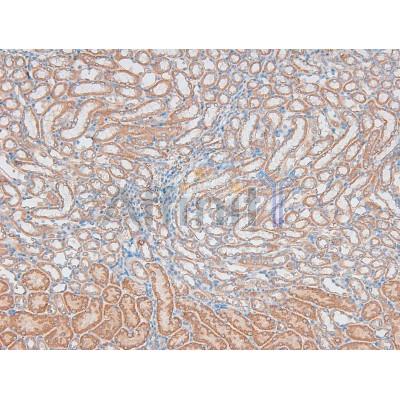Phospho-DNA Ligase IV (Thr650) Antibody - #AF8089
| Product: | Phospho-DNA Ligase IV (Thr650) Antibody |
| Catalog: | AF8089 |
| Description: | Rabbit polyclonal antibody to Phospho-DNA Ligase IV (Thr650) |
| Application: | WB IHC |
| Reactivity: | Human, Mouse |
| Mol.Wt.: | 103 KD; 104kD(Calculated). |
| Uniprot: | P49917 |
| RRID: | AB_2840152 |
Related Downloads
Protocols
Product Info
*The optimal dilutions should be determined by the end user. For optimal experimental results, antibody reuse is not recommended.
*Tips:
WB: For western blot detection of denatured protein samples. IHC: For immunohistochemical detection of paraffin sections (IHC-p) or frozen sections (IHC-f) of tissue samples. IF/ICC: For immunofluorescence detection of cell samples. ELISA(peptide): For ELISA detection of antigenic peptide.
Cite Format: Affinity Biosciences Cat# AF8089, RRID:AB_2840152.
Fold/Unfold
DNA ligase IV ATP dependent; DNA joinase; DNA ligase 4; DNA ligase IV; DNA repair enzyme; DNLI4_HUMAN; LIG 4; LIG4; LIG4S; Ligase IV; Ligase IV DNA ATP dependent; Polydeoxyribonucleotide synthase [ATP] 4; Polydeoxyribonucleotide synthase 4; Polydeoxyribonucleotide synthase; Polynucleotide ligase; Sealase;
Immunogens
A synthesized peptide derived from human DNA Ligase IV around the phosphorylation site of Thr650.
- P49917 DNLI4_HUMAN:
- Protein BLAST With
- NCBI/
- ExPASy/
- Uniprot
MAASQTSQTVASHVPFADLCSTLERIQKSKGRAEKIRHFREFLDSWRKFHDALHKNHKDVTDSFYPAMRLILPQLERERMAYGIKETMLAKLYIELLNLPRDGKDALKLLNYRTPTGTHGDAGDFAMIAYFVLKPRCLQKGSLTIQQVNDLLDSIASNNSAKRKDLIKKSLLQLITQSSALEQKWLIRMIIKDLKLGVSQQTIFSVFHNDAAELHNVTTDLEKVCRQLHDPSVGLSDISITLFSAFKPMLAAIADIEHIEKDMKHQSFYIETKLDGERMQMHKDGDVYKYFSRNGYNYTDQFGASPTEGSLTPFIHNAFKADIQICILDGEMMAYNPNTQTFMQKGTKFDIKRMVEDSDLQTCYCVFDVLMVNNKKLGHETLRKRYEILSSIFTPIPGRIEIVQKTQAHTKNEVIDALNEAIDKREEGIMVKQPLSIYKPDKRGEGWLKIKPEYVSGLMDELDILIVGGYWGKGSRGGMMSHFLCAVAEKPPPGEKPSVFHTLSRVGSGCTMKELYDLGLKLAKYWKPFHRKAPPSSILCGTEKPEVYIEPCNSVIVQIKAAEIVPSDMYKTGCTLRFPRIEKIRDDKEWHECMTLDDLEQLRGKASGKLASKHLYIGGDDEPQEKKRKAAPKMKKVIGIIEHLKAPNLTNVNKISNIFEDVEFCVMSGTDSQPKPDLENRIAEFGGYIVQNPGPDTYCVIAGSENIRVKNIILSNKHDVVKPAWLLECFKTKSFVPWQPRFMIHMCPSTKEHFAREYDCYGDSYFIDTDLNQLKEVFSGIKNSNEQTPEEMASLIADLEYRYSWDCSPLSMFRRHTVYLDSYAVINDLSTKNEGTRLAIKALELRFHGAKVVSCLAEGVSHVIIGEDHSRVADFKAFRRTFKRKFKILKESWVTDSIDKCELQEENQYLI
Research Backgrounds
Efficiently joins single-strand breaks in a double-stranded polydeoxynucleotide in an ATP-dependent reaction. Involved in DNA non-homologous end joining (NHEJ) required for double-strand break repair and V(D)J recombination. The LIG4-XRCC4 complex is responsible for the NHEJ ligation step, and XRCC4 enhances the joining activity of LIG4. Binding of the LIG4-XRCC4 complex to DNA ends is dependent on the assembly of the DNA-dependent protein kinase complex DNA-PK to these DNA ends.
Nucleus.
Testis, thymus, prostate and heart.
Belongs to the ATP-dependent DNA ligase family.
Research Fields
· Genetic Information Processing > Replication and repair > Non-homologous end-joining.
Restrictive clause
Affinity Biosciences tests all products strictly. Citations are provided as a resource for additional applications that have not been validated by Affinity Biosciences. Please choose the appropriate format for each application and consult Materials and Methods sections for additional details about the use of any product in these publications.
For Research Use Only.
Not for use in diagnostic or therapeutic procedures. Not for resale. Not for distribution without written consent. Affinity Biosciences will not be held responsible for patent infringement or other violations that may occur with the use of our products. Affinity Biosciences, Affinity Biosciences Logo and all other trademarks are the property of Affinity Biosciences LTD.


